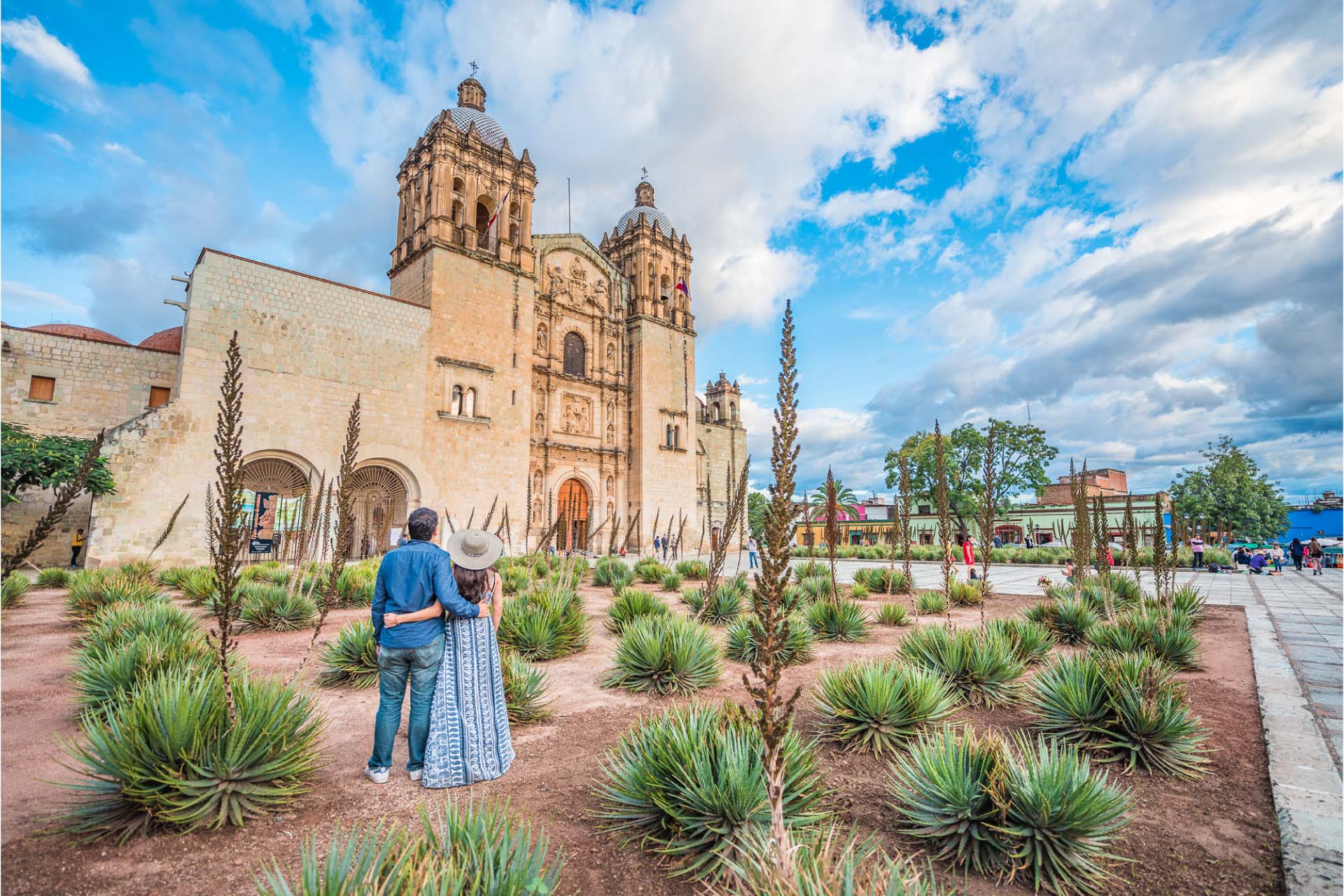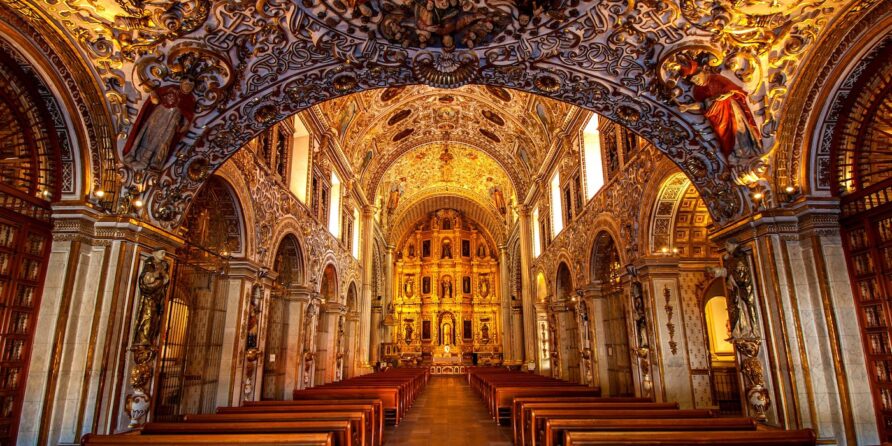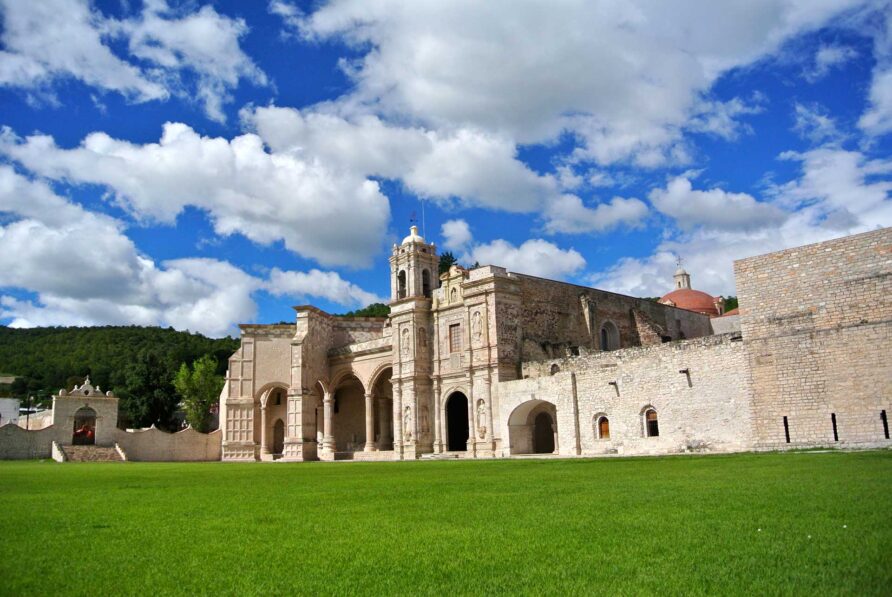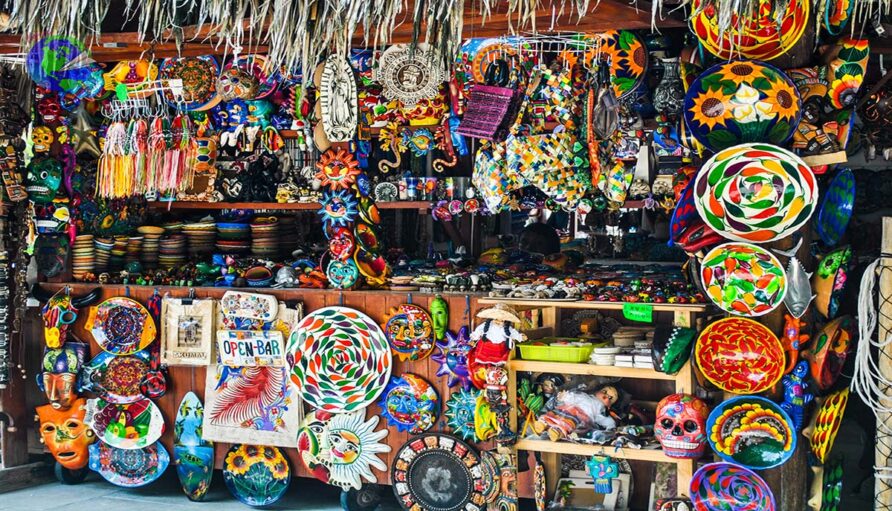Ro-House » Oaxaca »The City of Oaxaca
Tourism in Oaxaca de Juárez
Oaxaca is the most diverse state in Mexico. It has peaks that reach more than 3,000 meters in height, caverns that are among the deepest in the world, virgin beaches, secluded forests and sunny valleys. Oaxaca is rich in traditions and customs and it has the largest ethnic population in Mexico.
Oaxaca City, the state capital, is famous for its architecture and rich cultural traditions. Oaxaca also has a splendid and varied cuisine and a spring climate throughout the year. UNESCO declared the city a Cultural Heritage of Humanity.
The historical heritage attracts attention when traveling through the city; you can visit the old Plaza Mayor, the Government Palace, the art nouveau style kiosk, the Cathedral with its baroque façade and the portals with shops and restaurants. The sidewalk cafes are a favorite with locals and tourists alike. Here you can enjoy, under the shade of huge laurels from India, the famous Oaxaca chocolate as well as the mezcal with orange juice and "little worm" salt. This is also a common place for concerts or fireworks displays.
The museums and galleries of Oaxaca house many of the most valuable treasures of the region: from the jewels of Monte Alban to internationally distinguished contemporary artists. The small art galleries in the shops are full of provocative and wonderfully unique proposals. And the markets offer an incredible variety of colorful designs. Oaxaca is one of the richest places for crafts in Mexico. The climate goes from semi-dry-semi-warm in the valleys to humid in the eastern mountain range.


Tourist Attractions in Oaxaca City

TOUR 1

The Arquitos of Xochimilco. This aqueduct was built in 1727 and completed in 1751. It is approximately 300 meters long and is made up of green quarry walls. It begins in the town of San Felipe and ends at the water box at the corner of the Temple of Carmen Alto. There are sections that remain intact and it is a pleasant walk.
Oaxacan Institute of Crafts (ARIPO). It is located in a beautiful colonial house. Here the most varied crafts that are made in the state are exhibited and sold.
Juarez House Museum. Construction dating from the 18th century that was the house of Don Antonio Salanueva where Don Benito Juárez lived as a child. The museum reveals the daily life of Juárez during his stay in Oaxaca. The rooms house the bookbinding workshop, some documents from the Reform, the Intervention and some personal belongings of Don Benito Juárez. Schedule: Tuesday to Sunday from 10:00 a.m. to 7:00 p.m..
Temple and Former Convent of Carmen Alto. Its construction, as well as that of the convent, was carried out at the end of the 17th century by the order of the Discalced Carmelites in the place and with some of the materials of an old pre-Hispanic temple. The name of Alto is because this temple was exclusively for the Spanish, since there was another Del Carmen Bajo temple that was for mestizos and mulattos. On the façade there is a relief of the Virgen del Carmen. The main altar is of a sober neoclassical. On one side of the Temple is the Plazuela del Carmen Alto.
Institute of Graphic Arts of Oaxaca (IAGO). Its collection shows the best of universal and contemporary graphics. It was founded by the famous painter Francisco Toledo and his collection is considered one of the most important in Latin America. It has a specialized art library, Cineclub, Photographic Center, Music Library, Shop and Gallery. Schedule: Monday to Sunday from 9:30 a.m. to 8:00 p.m.

Santo Domingo Cultural Center. It is a complex that is located in the Ex Convent of Santo Domingo. It has the Museum of the Cultures of Oaxaca; the Public Newspaper Library of Oaxaca Néstor Sánchez, with an auditorium where exhibitions, conferences, forums and concerts are organized; the Fray Francisco de Burgoa Library with a collection of more than thirty thousand titles, with volumes published from 1484 to 1940; and the Ethnobotanical Garden with more than a thousand species of plants native to Oaxaca. The garden has guided tours where not only plants are discussed, but also their history.
Museum of the Cultures of Oaxaca. It is located in the beautiful Ex Convent of Santo Domingo. It is the most important museum in the state and offers an archaeological, historical and ethnographic panorama of the Oaxacan cultures. The museum has 14 rooms that cover 10,000 years of the history of the state of Oaxaca. It exhibits Mixtec and Zapotec archeology and the treasure from tomb No. 7 of Monte Albán, which consists of beautiful pieces of gold, silver, jade, turquoise and obsidian. It also has important colonial pieces and an interesting ethnological sample of the 15 indigenous groups of this region. In what were Dominican cells, "interactive rooms" have been installed, where the public can learn more about the various artisan trades in the state with the support of multimedia technology. Schedule: Tuesday to Sunday from 10:00 a.m. to 7:00 p.m.

Temple of Santo Domingo de Guzmán. The first construction projects date from 1551, however the conventual complex was inaugurated until 1608, still without being finished. Monumental architectural complex of the Dominican order that consists of the Temple, the Former Convent, the garden and a small square that is used as the setting for some popular festivals. It is one of the most beautiful examples of the Baroque in Mexico. The façade made of quarry has a sobriety that contrasts with its interior. The temple decoration is sumptuous and elaborate, most of the walls and ceiling are covered with stucco decoration in bright colors and gold leaf. It includes a genealogical tree of Santo Domingo de Guzmán carved on the ceiling and 36 paintings depicting landscapes from the Old Testament. The beautiful chapel of the Rosary upholstered in gold and the main altarpiece also stand out.
Temple of the Precious Blood of Christ. Dating from the seventeenth century, it was used as a city cemetery. This temple was consecrated in 1689. Here the traditional Procession of Silence takes place in Holy Week.
Museum of Philately (MUFI). It is the only museum dedicated exclusively to postal art in Latin America. It is located in a beautiful colonial building that has been adapted with modern museography equipment to guarantee the conservation of the small stamps. It exhibits a collection of more than 200,000 pieces from around the world, arranged chronologically. The Black Penny stamp, the first postage stamp in Mexico and some letters sent by the painter Frida Kahlo to her doctor stand out. It has a library and souvenir shop. Schedule: Tuesday to Sunday from 10:00 a.m. to 8:00 p.m.

Manuel Álvarez Bravo Photographic Center. It has an important photographic collection of important authors such as Francis Alÿs, Manuel Álvarez Bravo, Hugo Brehme, Henri Cartier-Bresson, among others. It offers a library specialized in photography and a music library with more than 3,000 recordings of various currents such as classical, jazz, ethnic and Mexican popular music. The museum conducts workshops and encourages the rescue and conservation of photographic archives.
Museum of Contemporary Art of Oaxaca (MACO). It is representative of the constructions of the 18th century. The museum displays works by Oaxacan artists such as: Rufino Tamayo, Toledo, Nieto and Aquino among others. The ceiling of the museum's staircase stands out, where an interesting work by Toledo was captured, and a sculptural patio where conferences and film performances are held. Schedule: Open Wednesday to Monday from 10:30 a.m. to 8:00 p.m..
State Public Library. A house with beautiful corridors and spiky green stone columns built at the end of the 17th century. It has 5 rooms that house more than 6,000 publications on topics related to the history of Oaxaca. Exhibitions and cultural activities of different kinds are held regularly.

TOUR 2
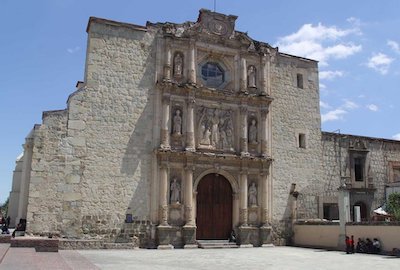
Church of San Agustín. In 1596 the temple and its convent were completed, however the current church dates from the 18th century. It is the widest temple in the city and lacks a dome and bell tower. Its Baroque style doorway is one of the most beautiful in the city. Inside, it houses authentic jewels such as the main altarpiece in the Solomonic Baroque style completely covered in laminated gold, its beautiful oil paintings and niches with polychrome sculptures.
Textile Museum (MTO). It is located in a fully restored 18th century mansion. The museum displays the wealth of handicrafts and the beauty of textile designs from the state as well as from other parts of the world. It houses six private collections with almost 6,000 pieces from different places and times. It also offers temporary exhibitions, conferences and workshops. Schedule: Monday to Saturday from 10:00 to 20:00. Sunday from 10:00 a.m. to 6:00 p.m.
government palace. Sober green quarry building that began to be built in 1832 and was completed in 1887. The great mural of the main staircase was made by the painter Arturo García Bustos, as well as another magnificent mural located in the vault and walls of the lateral staircase that overlooks to the east patio of the Government Palace. Schedule: Tuesday to Saturday from 9:30 a.m. to 6:00 p.m. Sunday from 9:30 a.m. to 4:00 p.m.
Zócalo or Constitution Square. The square has existed since the first design of the city made in 1529 and due to its monuments and buildings that surround it, it is considered one of the best examples of colonial architecture. It is the place where the Night of Radishes is celebrated on December 23 and the Cry of Independence on September 15. The center of the city is surrounded by portals with pleasant restaurants and shops that are the obligatory meeting place, where you can enjoy the Music Band and the Marimba that play in the central kiosk.

Cathedral of Our Lady of the Assumption. Its construction began in 1535 and was consecrated to the Virgin of the Assumption in 1733. It is dedicated to the Virgin of the Assumption, brought from Europe and made by the sculptor Tadolini. The façade dates from the 12th century and is made of green quarry in a baroque style. Inside there is an important collection of paintings; The highlights are a canvas representing Saint Christopher, dated by an anonymous author in 1720, and the oil paintings of the sacristy.
Alameda de Leon. Its construction began in 1535 and was consecrated to the Virgin of the Assumption in 1733. Also known as the Plazoleta de Cántaros, for being the place where artisans met to sell their products. It was renovated a few ago and is a nice gathering place.
Museum of Oaxacan Painters (MUPO). It is located in a 17th century mansion. It has spacious rooms where works by national and international artists are exhibited. Works by Rodolfo Morales, Alejandro Santiago and Francisco Toledo stand out. Its two patios are stages for various events. Schedule: Tuesday to Saturday from 10:00 a.m. to 8:00 p.m. Sunday from 10:00 a.m. to 6:00 p.m..
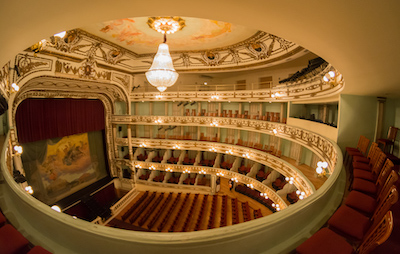
Macedonio Alcalá Theater. It was inaugurated in 1909, its Versailles style is characteristic of the Porfirian era. The important cultural enclosure shows a unique façade, since it is located in a corner and is composed of three doors topped with green quarry arches. Inside there is a clear French style with a white marble staircase and on its ceiling there is an allegory representing the Temple of Art. The curtain with a pictorial composition of the Parthenon and Mount Parnassus also stands out.
Antonia Labastida Garden. In 1881 the City Council named it "Plazuela de Orden y Libertad". It was renovated in a modern style and was inaugurated in 1894. Some time later it was renamed the Jardin Antonia Labastida. On the esplanade you can find a sample of local art. There are colorful handicrafts, exceptional scale altarpieces, and paintings and watercolors by Oaxacan painters.
Former Convent of Santa Catalina de Siena (Hotel Quinta Real). It dates from 1577, it was a public jail, Municipal Palace and in 1976, it was remodeled and converted into a hotel. Its marvelous hydraulic works from the colonial era stand out. The hotel dining room has a collection of sacred art.

TOUR 3

Market November 20. The history of the market dates back to the late 19th century. In this market you can enjoy the rich gastronomy of Oaxaca such as moles, jerky, tlayudas, grasshoppers and yema bread, as well as the famous hot chocolate. Handicrafts are also sold. It is a place to enjoy the flavors, smells and colors of Oaxaca.
Temple of San Juan de Dios. Here the Ermita de Santa Catarina Mártir was built, which was the first church in Oaxaca. From the arrival of the Juaninos, at the end of the 17th century, it was dedicated to San Juan de Dios. Its façade is in the neoclassical style and inside the 17th century oil paintings that illustrate the life of Oaxaca and the paintings on the ceiling by Urbano Olivera stand out.
Benito Juárez Market. It is the most traditional market, here you can buy handicrafts, flowers, leather objects, hats, knives, as well as typical products such as mezcal, moles, cheese, chocolate and grasshoppers. Here you can find products at good prices.

Artisan market. Here you can find the largest variety of crafts in the State, such as: Carpets, huipiles, dresses, sarapes, bags and ceramic pieces, among others.
Temple of the Society of Jesus. Beautiful temple built by the Jesuits in 1579. With the departure of the Society of Jesus, the temple was occupied by the Nuns of La Concepción. With the exception of a few columns, most of the original temple has been lost. Its façade is in the Baroque style with some Plateresque elements. The main altarpiece preserves part of its old forms and its gold cover.

TOUR 4

Basilica of the Solitude. Built between 1682 and 1697, the temple exhibits an extraordinary baroque doorway in the form of a screen richly carved in various quarries, considered one of the most beautiful in the city. Inside, the statue of the Virgen de la Soledad, declared patron of Oaxaca since 1909, a beautiful organ from the 18th century and the 18th century paintings on the sides of the presbytery stand out. The Ex Convent is currently the Municipal Palace. The Religious Museum annexed to the temple is worth visiting. On December 18, the Virgen de la Soledad is celebrated here.
Church of Carmen Bajo. The church dates from the 16th century and was first called "Tears of San Pedro". This church was the one that mestizos and mulattos could visit. The current temple is a reconstruction of the first hermitage that was seriously damaged by an earthquake in 1801 and by a fire in 1862. Its exterior architecture is voluminous and rich in finishes, which contrasts with the simplicity of the interior decoration where they stand out. the altarpieces from the 19th century, and some paintings from the early 20th century.
Temple of San José de Gracia. Its construction was carried out between 1588-1594, it housed the Spanish Capuchin nuns and is currently a school of Fine Arts.
Dance Square. Right at the foot of Cerro del Fortín, the square is built with green quarry, taking advantage of the natural slope of the land to make the stands. Various cultural and artistic activities are presented here.
Socrates Garden. Formerly it was the Plazuela de La Soledad. It is the place to enjoy ice creams and sorbets recognized worldwide for their quality and variety of flavors.
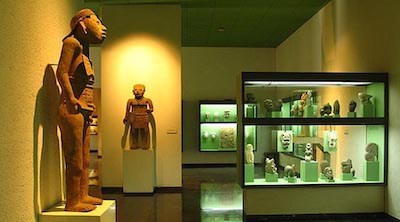
Rufino Tamayo Museum of Pre-Hispanic Art of Mexico. It is located in a 17th century house built with green quarry. The museum exhibits in its five rooms, the collection of pre-Hispanic art donated by the Oaxacan painter Rufino Tamayo that consists of more than a thousand pieces. It is considered one of the best collections of pottery and pre-Hispanic sculpture in the country. Schedule: Monday to Saturday from 10 a.m. to 2 p.m. and from 16 to 19 hrs. Sundays from 10 a.m. to 3 p.m. Closed on Tuesdays.
Temple of San Felipe Neri. The temple has a beautiful façade made of green quarry that is one of the most extraordinary examples of the baroque stipe from the late 18th century. Its golden altarpiece is a marvel of art and beauty. Four huge oval medallions with beautiful paintings of archangels and other paintings by José de Páez and Agustín de Santaella also stand out. Here they were married in 1841, Don Benito Juárez and Doña Margarita Maza.
Belber Jiménez Museum. It has an exhibition that includes jewelry and goldsmiths of exquisite designs, reliquaries from the 16th century, wooden trunks from the 12th century, beautiful textiles from the 19th century and a beautiful display of popular art. Schedule: Monday to Saturday from 10:00 a.m. to 5:00 p.m..
Temple of San Cosme and San Damián. Temple built in the middle of the 16th century. It was rebuilt in the late 19th century using two types of quarry.

TOUR 5
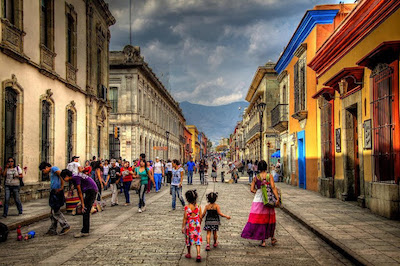
Macedonio Alcalá Tourist Walker. This is the main pedestrian walkway in the city. Walking through the walkway you can find museums, shops, restaurants, temples, galleries, as well as cafes and bars, making it an always interesting walk and a lively night scene.
Paseo Juárez or El Llano. It is one of the largest and oldest places of recreation in Oaxaca. The park has an internet signal so you can see both tourists and locals enjoying the garden and its fountains. In this garden, they are celebrated during Lent, the “Fridays of the Llano”, where the students give flowers to the ladies who walk to the rhythm of the music of the state and collect more roses is the winner.
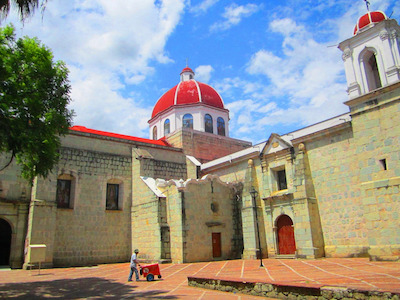
Temple and Ex-Convent of Guadalupe or Betlemitas. It was built in 1686 and was occupied by the Bethlehem friars who were entrusted with health and education. The Belem Chapel was built in 1807 and is currently a school.
Temple of San Juan Matías Jalatlaco. It dates back to the 18th century, its façade decorated with geometric figures carved in the quarry and an impressive 19th century organ stand out. One of the 9 neighborhoods that make up the city of Oaxaca is located in the Barrio de San Matías Jalatlaco. This neighborhood seems to take you on a journey back in time, with its cobbled and quiet streets lined with colonial buildings.
Temple of Our Lady of Patrocinio. The date of construction is not certain, like many other temples in the city, it has suffered damage and has been remodeled several times. The ornamentation of its facade is different from the other temples in the City.

More Tourist Attractions in Oaxaca
Oaxaca's culinary tradition is extraordinary and deeply rooted. There are fourteen different ethnic groups, with their own dishes. It is an area of incomparable wealth for the tourist interested in gastronomy, ethnology and culture in general. Oaxaca is the land of mezcal, tlayudas and the famous seven moles. You have to dedicate several days to it. Oaxacan gastronomy is one of the cultural manifestations that identify and define its people, due to its variety, richness and complexity that have been preserved through the centuries. The best way to enjoy Oaxacan food is by tasting it, from the “strong” dishes that are used to enjoying at lunchtime; like the traditional Oaxacan snacks that can be enjoyed at any time of the day.
In the state of Oaxaca there are many customs and traditions throughout the year, and within the state, said that they have the same purpose of celebration but with different things, in fact from one region to another or even more from one town to another, the Customs vary for perhaps details but that is what makes them authentic. Oaxaca has deep-rooted customs and traditions. All the holidays are celebrated, the profane and the religious ones. The festival calendar is extensive due to the diversity of ethnic groups, which they still conserve.
The vast Oaxacan cuisine is distinguished by its tradition and the use of regional ingredients. Not for nothing has it positioned itself as the Best Tourist City in the World and the Best Gourmet Destination. In the presentation of the 2021 edition of The Mexico Gastronomic Guide "The Great Restaurants of Mexico" 278 restaurants located throughout the Mexican Republic were recognized, on this occasion, there were 16 Oaxacan restaurants that were placed in the list .
Monte Albán is the most important archaeological zone of the Oaxacan entity, of unique regional importance due to the religious, political and economic control that the Zapotec state exercised over the population of the Valley of Oaxaca for more than thirteen centuries. It has been named by UNESCO as Cultural Heritage of Humanity along with the city of Oaxaca on December 11, 1987. The heritage of the Zapotec world reaches us through the magnificent archaeological sites designed in the Valley of Oaxaca. Of these, the city of Monte Albán stands out for its enormous importance as an economic, political and religious hub (it was the first urban complex in Mesoamerica); by its extension, almost as big as the current capital of Oaxaca; and for its long life, started around 500 BC and concluded around 850 AD
The Santo Domingo Cultural Center is a cultural complex that is located in what was one of the most important convents in the colony. It is a large convent in which the Museum of the Cultures of Oaxaca, the Fray Francisco de Burgoa Library and the Ethnobotanical Garden have been established. The Néstor Sánchez Public Newspaper Library is located in a building that is part of the complex but dates from the 19th century. Apart from all these institutions brought together, the Santo Domingo Cultural Center has multipurpose spaces in the former convent, in which temporary exhibitions, conferences, courses, book presentations and concerts are held, among many other activities.
The beaches of the coast of the state of Oaxaca are among the most beautiful and complete in Mexico, thanks to a developing tourist infrastructure and the rich gastronomy of the Pacific. Along the 533 kilometers of coastline, the beaches of Oaxaca offer a wide variety of activities for lovers of water sports: snorkeling, diving, sport fishing, surfing, among others ... there is something for everyone!
Places such as Puerto Escondido, Mazunte, Zipolite, Carrizalillo, Puerto Ángel or the beaches of Huatulco will offer you the possibility of contemplating beautiful sunsets, delighting in intense adventure tourism or witnessing the exciting release of newborn turtles.
The City of Oaxaca is a destination that offers a great variety of tourist attractions and charms that leave anyone surprised. However, there are other places that are also worth knowing and are in the surroundings of the city, in whose surroundings various populations are located, each with its own personality and artisan tradition, accompanied by their respective customs, festivals and dishes. .
An ideal space for Alternative Tourism, Oaxaca offers activities such as walking, mountain biking, rappelling, climbing, zip-lining, horseback riding, observation of flora and fauna and more, in close contact with nature. The visitor can also witness the various aspects of local life, savor the gastronomy and enjoy the warmth of its people, as well as an offer of accommodation in hotels, ecotourism cabins, local houses or excellent camping areas. In its varied geography, it brings together not only a vast biodiversity, considered among the largest in the world, but also insurmountable cultural and ethnic riches, and the most different and beautiful natural settings.
The name mezcal has its roots in one of the ancient native languages of the area and translates as 'agave (also known as maguey) cooked'. Although pre-Hispanic Oaxaqueños used maguey to make pulque (an undistilled alcoholic beverage), it seems that the real advances in mezcal production occurred when the Spanish arrived in Oaxaca; by bringing with them their knowledge of distillation processes.
Oaxaca is famous throughout the world for its archaeological sites and the history they keep. Discover Monte Alban, Mitla, Yagul and more of these remote sites, which have made Oaxaca a World Heritage city, according to Unesco. The original Zapotec and Mixtec peoples of Oaxaca lived in the cities and religious centers of the valley of this city until the time of Spanish colonization. Today, there are still vestiges of these towns and places where you can meet them.
In Oaxaca we are proud to have 5 communities that have been awarded the title of Magic Towns of Mexico, a Magic Town is a town that has symbolic attributes, legends, history, transcendent events, everyday life, in short magic that they emanate in each of their socio-cultural manifestations, and that today mean a great opportunity for tourist use. The Magical Towns Program contributes to revalue a group of populations in the country that have always been in the collective imagination of the nation as a whole and that represent fresh and different alternatives for national and foreign visitors.
The Guelaguetza is an ancient tradition with pre-Hispanic roots related to agricultural ceremonies of gratitude to the gods for the arrival of the rains and the lifting of the harvest at the end of July and is the largest festival in Oaxaca. La Guelaguetza is a celebration of gratitude for the arrival of the rains and the harvests, in which representatives from all regions of the state gather in the capital to share their culture through dances, crafts and food.
Crafts in Oaxaca are so varied and of such good quality that they have become a tourist attraction. The ancestral traditions, the diversity in the ethnic groups, as well as the richness in the history of the state have been manifested in the great diversity of creations of more than half a million artisans that are registered in Oaxaca. In the center of the state is the City of Oaxaca, a fascinating and hospitable capital in whose surroundings various towns are located, each with its own personality and craft tradition, accompanied by their respective customs, festivals and dishes.

Guided Tours Oaxaca


